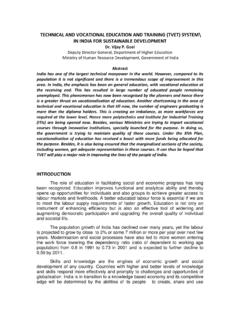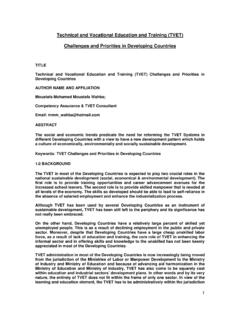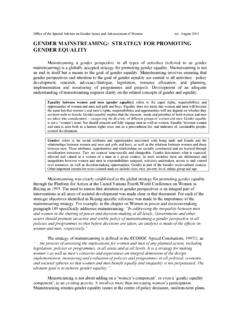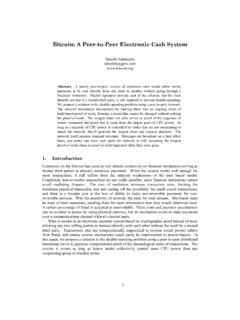Transcription of Emerging Trends in ICT for Education & Training
1 Emerging Trends in ICT for Education & Training Prof. Shyamal Majumdar, Director General, Colombo Plan Staff College Manila, Phillippines, Professor, National Institute of Technical Teachers Training & Research, Kolkata, India Regional Vice President, Asia & Pacific Region IVETA, 2002-2006 Email: Introduction During the past few years, the world has witnessed a phenomenal growth in communication technology, computer network and information technology. Development of new broadband communication services and convergence of telecommunication with computers have created numerous possibilities to use a variety of new technology tools for teaching and learning system.
2 The integration of computers and communications offers unprecedented opportunities to the Education systems with its capacity to integrate, enhance and interact with each other over a wide geographic distance in a meaningful way to achieve the learning objectives. The growth of these communication and computer systems, their ease of use, the power and diversity of information transfer allow teachers and students to have access to a world beyond the classroom [1]. It has the potential to transform the nature and process of the learning environment and envision a new learning culture.
3 Interactivity, flexibility and convenience have become the order of the day in the ICT supported environment. ICT opens up opportunities for learning because it enables learners to access, extend, transform and share ideas and information in multi-modal communication styles and format. It helps the learner to share learning resources and spaces, promote learner centered and collaborative learning principles and enhance critical thinking, creative thinking and problem solving skills. Not only mastering ICT skills, but also utilizing ICT to improve teaching and learning is of utmost importance for teachers in performing their role of creators of pedagogical environments.
4 While literature provides some evidence of the effectiveness of using ICT in technical considerations, little is known about which learning strategies and pedagogical framework should be used for Education and Training . How to construct these electronic teaching and learning environments so that they are based on specific epistemologies or knowledge bases? What will be the new vision and guiding principles of teacher development for pedagogy-technology integration? As we become increasingly supported by ICT, teaching and learning will not be the same as before. We will have to make use of the rich and exciting opportunities offered by the new technologies in Education to reach our new goal and vision.
5 To appreciate the integration of ICT in teaching and learning, we need to understand the major paradigm shifts in Education in recent years. Paradigm Shifts Education around the world is experiencing major paradigm shifts in educational practices of teaching and learning under the umbrella of ICT enabled learning environment. Whereas learning through facts, drill and practices, rules and procedures was more adaptive in earlier days, learning through projects and problems, inquiry and design, discovery and invention, creativity and diversity, action and reflection is perhaps more fitting for the present times.
6 The major hallmark of this learning transition is from teacher centered to learner focus paradigm. During the last three decades, the changes in educational environment have been phenomenal. The model, focus, role of the learner and technology has been changed drastically from traditional instruction to virtual learning environment as depicted below. Changes in Teaching-Learning Environment MODEL FOCUS ROLE OF LEARNER TECHNOLOGY TRADITIONAL TEACHERS PASSIVE CHALK & TALK INFORMATION LEARNERS ACTIVE PERSONAL COMPUTER KNOWLEDGE GROUP ADAPTIVE PC+ NETWORK Shifting the emphasis from teaching to learning can create a more interactive and engaging learning environment for teachers and learners.
7 This new environment also involves a change in roles of both teachers and learners. The role of the teachers will change from knowledge transmitter to that of facilitator, knowledge navigator and sometime as co-learner. The new role of teachers demands a new way of thinking and understanding of the new vision of learning process. Learners will have more responsibilities of their own learning as they seek out, find, synthesize, and share their knowledge with others [2]. ICT provides powerful tools to support the shift from teacher centred to learner centred paradigm and new roles of teacher, learner, curricula and new media.
8 The major shifts have been described in a tabular form below. Changes in Teachers' Roles From To Transmitter of Knowledge Guide & Facilitator of Knowledge Controller of Learning Creator of Learning Environment Always Expert Collaborator & Co-learner Learning to use ICT Using ICT to Enhance Learning Didactive/ Expository Interactive/Experiential/Exploratory Changes in Learners' Roles From To Passive Learner Active Learner Reproducer of Knowledge Producer of Knowledge Dependent Learner Autonomous Learner Solitary Learner Collaborative Learner Solely Learning Content Learning to Learn/Think/Create & Communicate Changes in Curricula & Delivery From To Memorizing Facts Inquiry Based
9 Artificial Teaching Exercises Authentic Learning Rigid Delivery (Fixed Time & Space) Open & Flexible Delivery (Any Time & Anywhere) Single Path Progression Multi Path Progression Changes in Media Applications From To Single Sense Stimulation Multi Sensory Stimulation Single Media Application Multimedia Application Delivery of Information Exchange of Information Monologue Communication Dialogue & Collaborative Analogue Resources Digital Resources All these changes taking place in learning and teaching demand a new learning environment to effectively harness the power of ICT to improve learning. ICT has the potential to transform the nature of Education : where, when, how and the way learning takes place.
10 It will facilitate the emergence of responsible knowledge society emphasizing life long learning with meaningful and enjoyable learning experiences. Creating New Cultures The integration of ICT into the very idea of teaching and learning always places pedagogy over technology. It is not the only concern to master ICT skills, but rather it involves using ICT to improve teaching and learning. The major emphasis of ICT infusion in pedagogy should be such that it tends to improve learning, motivate and engage learners, promote collaboration, foster enquiry and exploration, and create a new learner centered learning culture.











